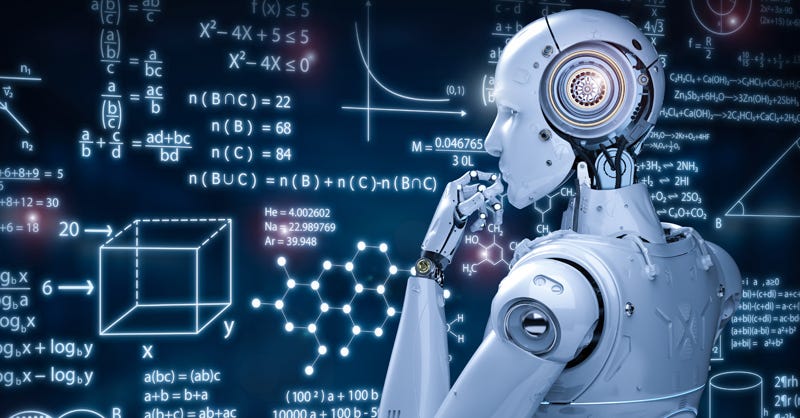All Categories
Featured
Table of Contents
- – Get This Report about Advanced Machine Learnin...
- – How Software Engineering Vs Machine Learning (...
- – The Ultimate Guide To How To Become A Machine...
- – Indicators on Machine Learning You Should Know
- – The 7-Second Trick For Aws Machine Learning ...
- – Get This Report about Machine Learning In Pr...
- – Machine Learning In A Nutshell For Software ...
Some people believe that that's dishonesty. Well, that's my entire job. If somebody else did it, I'm going to use what that person did. The lesson is putting that apart. I'm compeling myself to analyze the possible solutions. It's more regarding taking in the content and trying to apply those ideas and much less regarding discovering a collection that does the job or finding someone else that coded it.
Dig a little bit deeper in the mathematics at the beginning, just so I can build that foundation. Santiago: Ultimately, lesson number 7. I do not think that you have to understand the nuts and bolts of every algorithm before you use it.
I would certainly have to go and check back to really get a better instinct. That doesn't imply that I can not fix points making use of neural networks? It goes back to our sorting example I believe that's just bullshit recommendations.
As a designer, I've functioned on lots of, lots of systems and I've used many, several things that I do not comprehend the nuts and bolts of how it functions, despite the fact that I understand the influence that they have. That's the last lesson on that string. Alexey: The amusing thing is when I think of all these collections like Scikit-Learn the formulas they make use of inside to implement, for instance, logistic regression or something else, are not the same as the formulas we study in artificial intelligence classes.
Get This Report about Advanced Machine Learning Course
So even if we tried to find out to obtain all these fundamentals of artificial intelligence, at the end, the formulas that these libraries make use of are various. ? (30:22) Santiago: Yeah, absolutely. I believe we require a great deal a lot more materialism in the industry. Make a great deal even more of an influence. Or concentrating on delivering value and a bit much less of purism.

By the method, there are two different courses. I normally talk to those that wish to function in the industry that intend to have their influence there. There is a path for researchers which is completely various. I do not attempt to mention that because I do not know.
Yet right there outside, in the industry, materialism goes a lengthy way without a doubt. (32:13) Alexey: We had a comment that claimed "Really feels even more like motivational speech than talking concerning transitioning." So perhaps we must change. (32:40) Santiago: There you go, yeah. (32:48) Alexey: It is a great inspirational speech.
How Software Engineering Vs Machine Learning (Updated For ... can Save You Time, Stress, and Money.
One of the important things I wished to ask you. I am taking a note to speak about coming to be much better at coding. First, allow's cover a pair of things. (32:50) Alexey: Allow's start with core devices and structures that you need to discover to in fact shift. Allow's say I am a software program designer.
I know Java. I know SQL. I recognize exactly how to use Git. I recognize Celebration. Perhaps I understand Docker. All these points. And I find out about maker knowing, it appears like a great point. So, what are the core tools and structures? Yes, I enjoyed this video clip and I obtain persuaded that I don't require to get deep right into mathematics.
What are the core devices and structures that I need to find out to do this? (33:10) Santiago: Yeah, absolutely. Wonderful question. I believe, number one, you must begin discovering a little of Python. Given that you already know Java, I don't think it's going to be a massive transition for you.
Not because Python coincides as Java, yet in a week, you're gon na get a great deal of the differences there. You're gon na be able to make some development. That's leading. (33:47) Santiago: Then you get specific core devices that are mosting likely to be used throughout your entire career.
The Ultimate Guide To How To Become A Machine Learning Engineer
You get SciKit Learn for the collection of equipment discovering formulas. Those are devices that you're going to have to be using. I do not recommend simply going and discovering regarding them out of the blue.
We can speak about certain programs later on. Take among those courses that are mosting likely to start presenting you to some issues and to some core concepts of machine learning. Santiago: There is a training course in Kaggle which is an intro. I do not remember the name, yet if you go to Kaggle, they have tutorials there free of cost.
What's good regarding it is that the only requirement for you is to understand Python. They're mosting likely to offer a problem and tell you exactly how to make use of choice trees to fix that particular problem. I think that process is exceptionally powerful, since you go from no equipment discovering history, to understanding what the issue is and why you can not fix it with what you recognize today, which is straight software application design practices.
Indicators on Machine Learning You Should Know
On the various other hand, ML engineers specialize in building and releasing artificial intelligence models. They focus on training versions with information to make forecasts or automate tasks. While there is overlap, AI engineers deal with more varied AI applications, while ML engineers have a narrower concentrate on artificial intelligence algorithms and their sensible implementation.

Artificial intelligence engineers concentrate on developing and releasing equipment understanding versions into production systems. They service engineering, making certain models are scalable, reliable, and incorporated into applications. On the various other hand, data researchers have a more comprehensive duty that includes data collection, cleaning, expedition, and structure designs. They are frequently in charge of drawing out insights and making data-driven choices.
As companies increasingly adopt AI and artificial intelligence technologies, the need for skilled specialists grows. Artificial intelligence engineers work with advanced jobs, contribute to advancement, and have competitive wages. Nonetheless, success in this field calls for constant understanding and maintaining up with developing innovations and methods. Machine discovering functions are usually well-paid, with the potential for high earning potential.
ML is fundamentally various from traditional software program growth as it focuses on training computer systems to pick up from data, as opposed to programming explicit guidelines that are performed methodically. Unpredictability of results: You are probably made use of to creating code with foreseeable outputs, whether your feature runs when or a thousand times. In ML, however, the end results are less certain.

Pre-training and fine-tuning: How these versions are trained on huge datasets and after that fine-tuned for certain jobs. Applications of LLMs: Such as message generation, belief analysis and details search and retrieval. Documents like "Interest is All You Need" by Vaswani et al., which presented transformers. On-line tutorials and programs concentrating on NLP and transformers, such as the Hugging Face course on transformers.
The 7-Second Trick For Aws Machine Learning Engineer Nanodegree
The capacity to manage codebases, merge changes, and resolve disputes is just as vital in ML advancement as it remains in standard software program tasks. The skills established in debugging and screening software applications are highly transferable. While the context might alter from debugging application logic to determining issues in data processing or model training the underlying principles of systematic examination, hypothesis testing, and iterative improvement coincide.
Machine knowing, at its core, is greatly reliant on data and probability theory. These are critical for comprehending exactly how algorithms find out from information, make predictions, and evaluate their performance.
For those interested in LLMs, a comprehensive understanding of deep learning designs is helpful. This consists of not just the auto mechanics of neural networks but likewise the style of details versions for various usage instances, like CNNs (Convolutional Neural Networks) for picture handling and RNNs (Frequent Neural Networks) and transformers for consecutive information and all-natural language handling.
You ought to understand these problems and discover strategies for recognizing, reducing, and communicating about predisposition in ML versions. This consists of the prospective effect of automated decisions and the honest implications. Several versions, particularly LLMs, call for considerable computational sources that are often given by cloud platforms like AWS, Google Cloud, and Azure.
Building these skills will certainly not only facilitate a successful shift into ML but additionally guarantee that designers can add successfully and properly to the innovation of this dynamic area. Theory is necessary, however absolutely nothing beats hands-on experience. Begin functioning on jobs that enable you to use what you've discovered in a sensible context.
Develop your projects: Start with straightforward applications, such as a chatbot or a text summarization tool, and gradually boost complexity. The field of ML and LLMs is rapidly progressing, with new breakthroughs and technologies arising consistently.
Get This Report about Machine Learning In Production
Contribute to open-source jobs or create blog site messages about your understanding trip and jobs. As you acquire know-how, start looking for chances to incorporate ML and LLMs right into your job, or look for new duties concentrated on these innovations.

Prospective use instances in interactive software program, such as suggestion systems and automated decision-making. Understanding unpredictability, fundamental analytical steps, and possibility circulations. Vectors, matrices, and their role in ML algorithms. Mistake reduction methods and slope descent clarified just. Terms like design, dataset, functions, tags, training, reasoning, and recognition. Data collection, preprocessing techniques, model training, assessment processes, and release factors to consider.
Choice Trees and Random Forests: Instinctive and interpretable designs. Assistance Vector Machines: Maximum margin classification. Matching problem types with suitable models. Stabilizing performance and intricacy. Basic framework of semantic networks: neurons, layers, activation features. Split calculation and onward propagation. Feedforward Networks, Convolutional Neural Networks (CNNs), Recurring Neural Networks (RNNs). Photo recognition, series forecast, and time-series evaluation.
Continuous Integration/Continuous Release (CI/CD) for ML workflows. Model monitoring, versioning, and efficiency monitoring. Spotting and resolving changes in design efficiency over time.
Machine Learning In A Nutshell For Software Engineers Can Be Fun For Anyone

You'll be presented to 3 of the most appropriate elements of the AI/ML technique; overseen learning, neural networks, and deep understanding. You'll comprehend the distinctions in between conventional shows and device learning by hands-on development in supervised discovering before building out intricate dispersed applications with neural networks.
This program acts as a guide to maker lear ... Show Extra.
Table of Contents
- – Get This Report about Advanced Machine Learnin...
- – How Software Engineering Vs Machine Learning (...
- – The Ultimate Guide To How To Become A Machine...
- – Indicators on Machine Learning You Should Know
- – The 7-Second Trick For Aws Machine Learning ...
- – Get This Report about Machine Learning In Pr...
- – Machine Learning In A Nutshell For Software ...
Latest Posts
Mock Coding Interviews – How To Improve Your Performance
Facebook Software Engineer Interview Guide – What You Need To Know
How To Pass System Design Interviews At Faang Companies
More
Latest Posts
Mock Coding Interviews – How To Improve Your Performance
Facebook Software Engineer Interview Guide – What You Need To Know
How To Pass System Design Interviews At Faang Companies